Artificial respiration must be done in any situation, even without previous experience, since a person's life depends on resuscitation manipulations. Mechanical ventilation and cardiac massage allow you to maintain the supply of oxygen to the brain for some time after the cessation of breathing.
The duration of clinical death depends on many factors. But if resuscitation is not carried out, clinical death occurs. Irreversible processes lead to brain death.
Record content:
- 1 Symptoms of cardiac arrest and breathing
- 2 Why is artificial lung ventilation necessary?
- 3 Types of artificial respiration
- 4 Indications and contraindications for first aid
- 5 Rules for saving a person in cardiac arrest
-
6 How to do closed heart massage and forced ventilation?
- 6.1 Preliminary actions
- 6.2 Artificial respiration from mouth to mouth
- 6.3 Artificial respiration from mouth to nose
- 6.4 Features of the procedure in children
- 6.5 Two-person cardiopulmonary resuscitation
- 6.6 Determining the correctness of resuscitation
- 7 Complications of artificial respiration
- 8 Signs of Success
- 9 How long does it take to reanimate a person?
- 10 World methods of artificial respiration
- 11 Common errors of artificial respiration
- 12 Artificial respiration video
Symptoms of cardiac arrest and breathing
Simple actions will help determine the work of the heart and respiratory system.
In this case, the following clinical signs are found:
| Name | Description |
| Lack of pulse | You can determine whether there are heart beats or not by placing two fingers on the neck under the cheekbones. On the left side of the chin is the carotid artery. |
| Lack of breath | You can listen to the work of the heart with your ear, putting it to the chest. The hand can also be used to determine breathing by placing it on the chest in the region of the heart. Bring a mirror to the victim's mouth. If it fogs up, there is breathing. |
| Pupil reaction | It is necessary to raise the eyelid and shine a flashlight on the pupil. If there is no reaction, then the heart has stopped. |
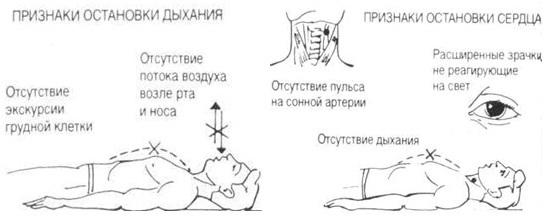
It is important to start doing artificial respiration immediately after a person loses consciousness and cardiac arrest.
Why is artificial lung ventilation necessary?
Cardiopulmonary resuscitation is performed when the patient cannot breathe on their own. Mechanical ventilation is required to maintain gas exchange between the alveoli and the environment in the lungs.
Types of artificial respiration
In medicine, the following types of artificial lung ventilation are distinguished:
| Name | Description |
| Mouth to mouth | The classic resuscitation procedure performed for forced ventilation of the lungs. |
| Mouth to nose | Air is blown into the victim's lungs through the nose. In this case, the person's mouth is tightly closed. |
| Manual artificial respiration | Resuscitation manipulations are performed according to the method of Schaeffer, Labor, Howard, Callistov, Frank Ives. |
| Automatic | Special equipment is used in inpatient facilities or by ambulance doctors. |
| Tracheal intubation | A method of forced ventilation of the lungs, which involves the introduction of a special probe with a tube into the trachea. It is carried out in case of impossible restoration of the respiratory process by manual methods. |
| Tracheostomy | The procedure is performed in emergency situations. The doctor performs a minor surgery to gain access directly to the trachea. |
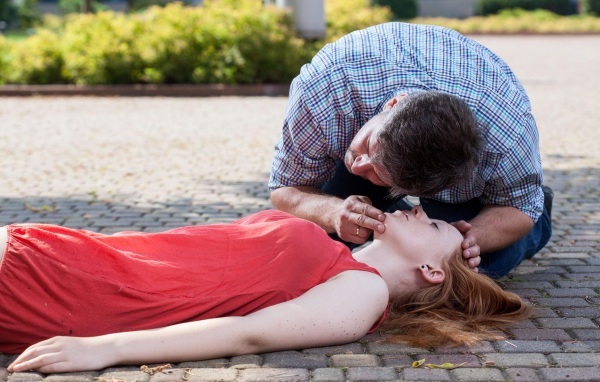
Artificial respiration is performed when the victim cannot breathe on his own. The method of carrying out resuscitation measures is selected taking into account the condition of the person.
Indications and contraindications for first aid
Artificial respiration is necessary in any situation when the volume of ventilation is critically low. Cardiopulmonary resuscitation will ensure normal gas exchange.
There are the following indications for artificial respiration:
| Name | Description |
| Violation of the central regulation of respiration | Malfunctions of the respiratory system occur as a result of impaired cerebral circulation. The same thing happens against the background of malignant tumors or after a brain injury. |
| Poisoning the body | We are talking about drug intoxication or poisoning of the human body by other methods. |
| Damage to the neuromuscular synapse, nerve pathways | A pathological condition often occurs against the background of an injury to the cervical spine, a viral lesion, or as a result of poisoning of the human body. The same is observed after the use of certain drugs that have a toxic effect. |
| Hypoventilation of the lungs | A pathological condition characterized by incomplete ventilation of the lungs. Blood oxygenation is impaired and it becomes difficult to remove carbon dioxide from the human body. |
| Bradystole | The frequency of contractions of the heart ventricles decreases. |
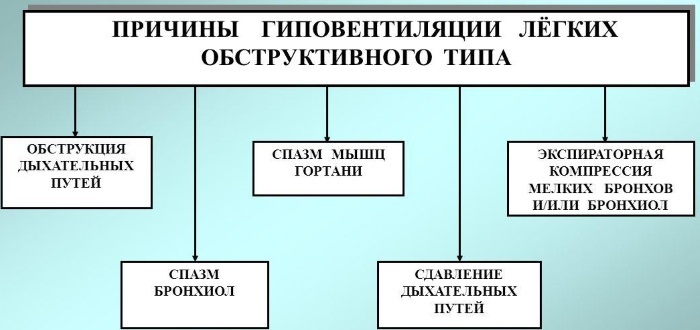
Diseases and injuries of the respiratory muscle, heart wall also require cardiopulmonary resuscitation. The same goes for obstructive and restrictive lung disease.
Artificial ventilation is also indicated if, after the administration of certain drugs, a person's breathing has stopped. This happens during the use of anesthesia during surgery.
As for contraindications to artificial respiration, there are no absolute prohibitions.
Among the contraindications, the following pathological conditions can be distinguished:
- extreme chronic heart failure;
- hopelessness of cardiopulmonary resuscitation;
- renal, hepatic and respiratory failure;
- cardiac arrest on the background of a long and severe illness;
- injuries and injuries to the body that are incompatible with human life;
- biological death of the victim.
There are limitations that affect the technique of resuscitation manipulations (impaired venous return of blood, trauma to the lungs).
Rules for saving a person in cardiac arrest
In case of cardiac arrest, you must immediately start resuscitation, since every minute is important. First of all, you should immediately call an ambulance. Then carry out artificial respiration, if necessary, heart massage.
The algorithm of actions is as follows:
- Lay the person straight, with his back down.
- Place a roller under the neck.
- Tilt your head back a little.
- Push the lower jaw forward.
- Remove all contents from the mouth (vomit, foam, mucus, foreign body).
- Perform cardiopulmonary resuscitation.
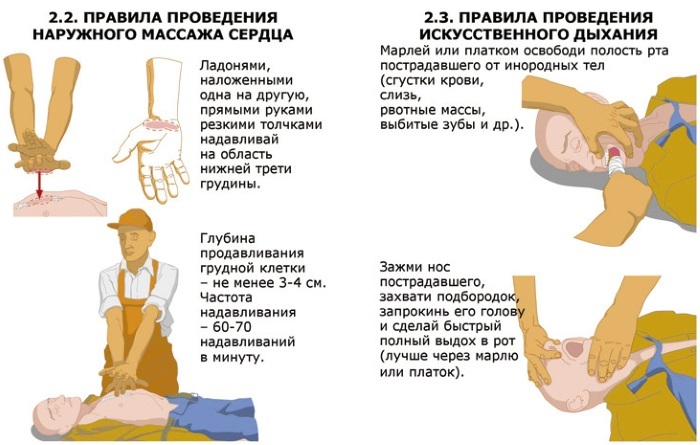
If assistance is provided by 2 people, it is important that each of them dealt with separately the restoration of breathing and the work of the heart.
How to do closed heart massage and forced ventilation?
Closed heart massage and forced ventilation of the lungs are carried out if the victim does not only have breathing, but also the pulse. It is important to know certain rules for carrying out resuscitation manipulations, since you can harm a person by blowing air into the lungs.
Preliminary actions
Artificial respiration will save a person's life if timely assistance is provided to the victim.
You must first carry out the following actions:
- Lay the person on their back on a hard surface.
- Free the airways.
- Tilt your head back slightly.
- Unbutton clothing for visual observation of the chest.
- Assess the condition of the victim and begin resuscitation manipulations.
Preliminary actions should not take more than 10 seconds. Taking into account the condition of the person, the most effective method of artificial respiration is chosen.
Artificial respiration from mouth to mouth
A common method of artificial respiration that can be performed even by a person without medical education.
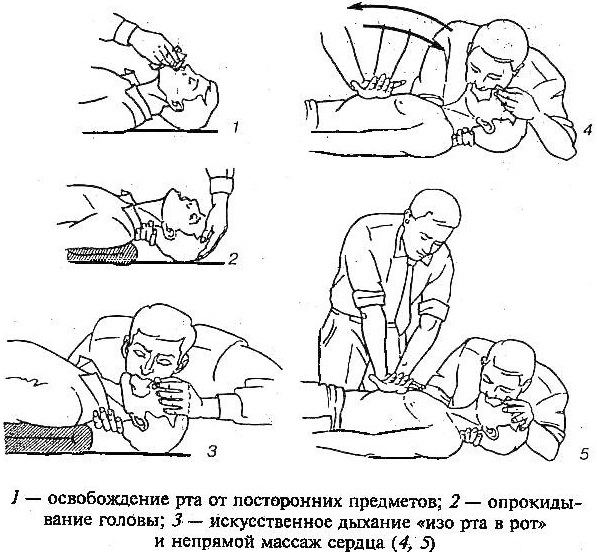
To provide assistance to the victim in a critical situation, the following actions must be taken:
- The victim's oral cavity must be checked for foreign bodies. They should be removed with your finger, after wrapping it with a bandage.
- The tightly closed jaw is opened with a spoon handle or other flat object.
- Cover the mouth of an unconscious person with a gauze cloth or a handkerchief that allows air to pass through. This is necessary to maintain simple hygiene and safety measures.
- The lips should be pressed as tightly as possible so that more air gets into the lungs.
- It is recommended to inhale oxygen for 1.5-2 minutes.
- Step back to let the air out.
First aid manipulations must be repeated 12-15 times per minute. One inhalation cycle should take no more than 4-5 seconds.
Artificial respiration from mouth to nose
The method of artificial respiration from mouth to nose is considered to be the most effective, since in the process of manipulation, air entering the stomach is completely excluded.
It is recommended to do artificial respiration as follows:
- It is necessary to fix the affected person's head. Place one hand on the forehead, the other to hold the chin.
- The victim's mouth must be tightly closed to prevent the escape of oxygen inhaled through the nose.
- Take a deep breath and exhale the air with maximum force into the victim's nose.
- After taking a few breaths, you should check the person's pulse.
It is important to watch for the chest, which will swell if all movements are performed correctly.
Features of the procedure in children
Cardiopulmonary resuscitation is more difficult for children, since there is a greater likelihood of breaking the victim's ribs. You can not hesitate with artificial respiration if the child does not show signs of life. The life of a little patient depends on the speed of providing first aid.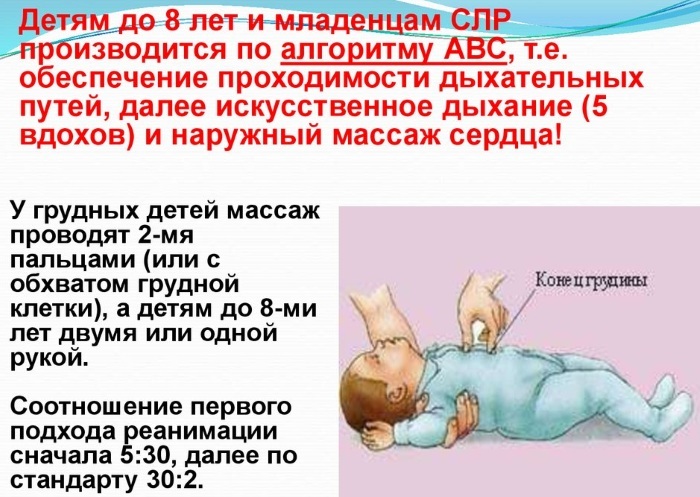
Artificial respiration should be given to the child through the mouth and nose, while performing an indirect heart massage with two fingers or one hand.
Cardiopulmonary resuscitation in children includes the following actions:
- Open the chest.
- Clear airways. Remove foreign objects from the oral cavity with a finger, after wrapping it with a bandage.
- The air should be blown into the child's respiratory tract for 1-1.5 seconds.
- Take 5 breaths, after each it is necessary to control the movement of the chest and let the oxygen come out.
- If there is no reaction, repeat the manipulations.
- If the chest does not move, then there is a foreign object in the respiratory system that must be quickly removed. To do this, it is recommended to make 5 sharp blows with the hand between the shoulder blades to the side of the head. Then check the oral cavity again.
- If the chest moves, continue resuscitation and move on to massage the heart muscle.
- Press your hand into the center of the chest. For newborn babies, a heart massage is performed with two fingers. For frightening children, pressure on the chest is exerted with one hand.
- It is not necessary to press hard, but often (100 times per minute). After every 30 pressures, it is necessary to continue to do artificial ventilation of the lungs for 2 breaths for 1-1.5 seconds.
All manipulations should be performed before the arrival of an ambulance. If the child has come to his senses, you cannot leave him alone. It is necessary to wrap it up in a blanket and lay it on its side. Cardiopulmonary resuscitation may be needed again at any time.
Two-person cardiopulmonary resuscitation
Cardiopulmonary resuscitation is recommended for two people, since manipulations require a lot of effort.
It is important to adhere to the following sequence:
- Get on your knees near the injured person, take a stable position.
- Determine the pressure point immediately.
- Cross your palms and put them on your chest, connect your fingers, straighten your arms.
- Make 30 hard presses to lower the chest by 4-5 cm.
- Then take 2 breaths.
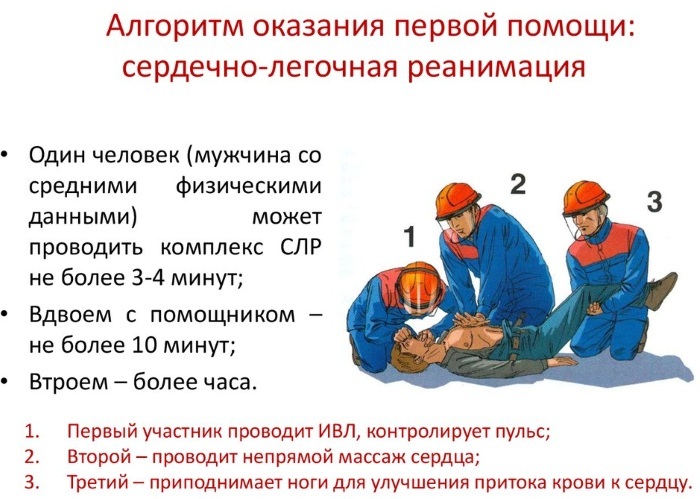
It is important to continue cardiopulmonary resuscitation until an ambulance arrives.
Determining the correctness of resuscitation
It is possible to determine how correctly emergency assistance was provided by certain external signs:
- the reaction of the pupils to light;
- the skin becomes pink;
- a pulse appears in the area of peripheral arteries;
- the victim slowly regains consciousness, begins to breathe on his own.
In the absence of a positive effect, biological death of a person occurs, many processes are irreversible, brain tissue perishes. The first signs of rigor mortis appear, and after a while, cadaveric spots.
Complications of artificial respiration
When the victim is on artificial ventilation for a long time lungs, the risk of negative consequences increases:
- getting air into the stomach;
- when the airway is introduced, vomiting appears;
- damage to the mucous membrane is possible;
- pneumothorax develops (air or gases accumulate in the pleural region);
- bilateral eustachitis (the mucous membrane of the auditory tube is affected by the inflammatory process);
- emphysema of the lungs (the disease is characterized by damage to the lung tissue).

The blood supply to the kidneys, liver and spleen is impaired. The muscles of the respiratory system atrophy, and intracranial pressure rises. An incorrectly selected method of artificial ventilation of the lungs entails the development of acidosis and alkalosis. Careful hygiene of the respiratory system will help prevent possible complications of resuscitation actions.
Signs of Success
Correct implementation of cardiopulmonary resuscitation leads to the fact that the victim has the following symptoms:
- blood pressure rises;
- a heart rate appears;
- spontaneous breathing is restored;
- the pupils are narrowed;
- the skin becomes less pale.
It is recommended to perform resuscitation manipulations for at least 10 minutes, and it is better until an ambulance arrives. Even if palpitations appear, artificial respiration should be continued for at least 1.5 hours.
How long does it take to reanimate a person?
Artificial respiration should be done within 30 minutes after the person has lost consciousness or cardiac arrest has occurred.
In the absence of effectiveness after resuscitation manipulations, vegetative death occurs.
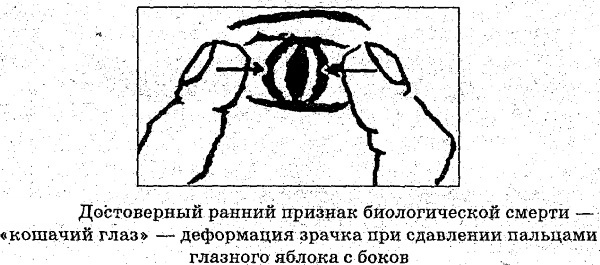 The death of the brain is accompanied by characteristic clinical signs, including a change in the shape of the pupil. It narrows when you press on the eyeball.
The death of the brain is accompanied by characteristic clinical signs, including a change in the shape of the pupil. It narrows when you press on the eyeball.
World methods of artificial respiration
There are world methods of artificial respiration, which are performed manually. The volume of the chest changes due to external forces applied.
| Name | Description |
| Schaeffer's method | The technique of artificial ventilation of the lungs, which is used, 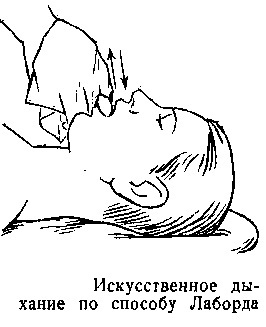 if a person has injured hands or is injured while in the water. The victim is laid face down, his head is turned to the side. The rescuer kneels so that the person's body is between the legs. Place your hands on the lower part of the chest, thumbs along the spine, and the rest on the ribs. When exhaling, it is necessary to bend forward and compress the chest. When inhaling, return to the starting position. When performing manipulations, do not bend your arms at the elbows. if a person has injured hands or is injured while in the water. The victim is laid face down, his head is turned to the side. The rescuer kneels so that the person's body is between the legs. Place your hands on the lower part of the chest, thumbs along the spine, and the rest on the ribs. When exhaling, it is necessary to bend forward and compress the chest. When inhaling, return to the starting position. When performing manipulations, do not bend your arms at the elbows. |
| Labor's way | It is applied immediately after cessation of breathing. It is necessary to grab the victim's tongue and pull it out with rhythmic movements. By imitating breathing movements, a person comes to his senses. The restoration of the respiratory process is evidenced by the resistance of the tongue when performing the described manipulations. |
| Callistov's method | A simple and effective method for ventilating the lungs. The victim is laid face down. A towel is placed on the back in the area of the shoulder blades, the ends are brought forward under the arms. The rescuer holds the towel by the ends, raising and lowering the victim's torso to a height of 8-9 cm. When lifting, the chest expands, the ribs rise, the position corresponds to inhalation. At the moment of lowering the victim's torso, oxygen exhalation is simulated. The towel can be replaced with a belt or scarf. |
| Howard's way | Lay the victim on his back with a roller. Put your hands behind your head, stretching forward. Turn the head to the side, pull out the tongue and fix it. The rescuer sits on the thigh area, puts his palms on the lower part of the chest, spreads his fingers. It is recommended to squeeze the chest for inhalation, and release it for exhalation. It is necessary to perform 12-16 manipulations in a minute. |
| Frank Willow's way | The artificial respiration method involves the use of a stretcher. They must be placed on a cross support in the middle. The height should be no more than half the length of the stretcher. The victim is laid face down on them, so that the face is turned to the side. Place your arms along the body. The person must be fixed in the area of the thighs and buttocks to the stretcher. When the head end of the structure is lowered, an inhalation is made, when it rises, an exhalation is carried out. At an inclination of 50 degrees, the maximum breathing volume is observed. |
| Nielsen's way | The victim must be placed on the floor with his stomach down. Turn your head to the side. Place your hands under your head so that they are bent and crossed. The person providing emergency assistance kneels down. With the palms, he presses on the chest in the area of the shoulder blades to exhale. Further, he takes the victim by the shoulders and lifts, taking a breath. |
The effectiveness of such methods is much lower in comparison with the classical method of resuscitation of artificial respiration. In each case, high physical costs and efforts are required. It will be difficult for one person to cope. But they still increase the chances of saving the victim.
Common errors of artificial respiration
Not everyone can do artificial respiration. If a person is not prepared, he can make mistakes, which is fraught with the injured person.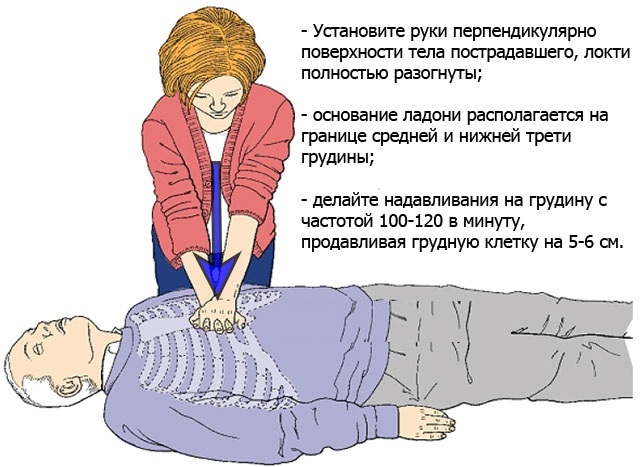
Everyone should know about them:
| Name | Description |
| Delay in the provision of emergency assistance | You can't hesitate with first aid. Before the vital systems of the human body fail, 8 minutes remain. |
| Incorrect mechanical ventilation (ALV) sequence | First of all, it is necessary to clear the airways and cleanse the oral cavity. Weak tightness. The lips should be pressed as tightly as possible, only then the lungs will receive a sufficient amount of oxygen. |
| Wasting time | In some situations, they try to open the victim's mouth, which cannot be done. In this situation, it is necessary to begin resuscitation through the nose. |
| Long pauses between breaths, small volume of blown air | A break is necessary for a short rest. Artificial respiration should be done quickly. Blow in air for 1.5-2 seconds 120 times per minute. |
| Lack of control | It is important to monitor the movement of the sternum. This is the first indication that CPR is being performed correctly. |
| Simultaneous ventilation and closed lung massage | In this situation, oxygen does not enter the bloodstream. |
You don't have to be a professional to save a person's life. It is enough to possess simple skills of cardiopulmonary resuscitation for the victim to survive until the ambulance arrives.
Artificial respiration and heart massage do not always give positive results. Manipulations can be stopped if, within 30 minutes after the start of resuscitation, the victim does not show signs of life. That is why it is necessary to start artificial ventilation of the lungs as early as possible, if there are no specific contraindications.
Artificial respiration video
How to do artificial respiration:


